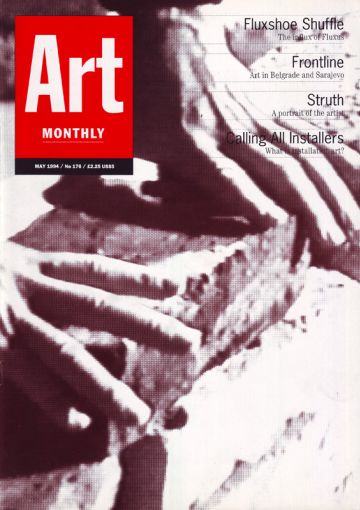Feature
Frontline
Caroline Juler reports on art under fire from Belgrade and Sarajevo
The Bosnian entry for the 1993 Venice Biennale was a set of photographs which showed the ruins of a Sarajevan cinema. It was not so much the devastated building which was being presented for the art world’s opprobrium (‘Look what they’ve done to us!’) but what the people of Sarajevo had done with the cinema’s burnt-out carcass.
A few months before the siege, the downtown Sutjeska Kino had been redesigned as an exhibition centre and, according to Dr Zdenko Lesić, who left Bosnia for London in January this year, its disappearance was ‘a sign of civic life being destroyed’. The Biennnale entry was to have been a full-sized replica of the Sutjeska ‘gallery’, but this proved too difficult to realise, so photographs were substituted instead. ‘The scenes of destruction were used as if they were a newly created reality’, explained Lesić.
The sight of the burning cinema struck home to such a degree that a group of young artists, among them Petr Waldeg and several others who already have international reputations, decided to turn the tables on their oppressors in the most eloquent way they could. For now the Sutjeska Kino is a gallery and an artists’ workshop. Granted, it is a gallery with a difference, without walls, ceiling, discreet lighting, temperature controls or storage space, and without a ticket kiosk or invigilators. Inspired by the stark wreckage, Waldeg and his friends rearranged some of the rubble and added extra touches of their own, such as a typewriter, a top hat, a bunch of flowers and an unfinished meal – concise symbols (Lesić called them ‘metonymics’) to highlight the surreal, dislocated, schizophrenic sense that life elsewhere was going on unconcerned and as normaL The giant, ‘found’ installation is a monumental irony in a situation which breeds them like flies on dead meat, but Lesić says the idea has caught the public imagination to such an extent that many people in the city have been collecting all kinds of war-damaged objets trouvés and displaying them as their own. And while Lesić, who is a university lecturer, expressed mild professorial criticism of this ‘parrot reaction’ which requires little creative effort on the part of the ‘artists’, he added, ‘who can blame them?’.
Zdenko Lesić’s wife, Katja Dorić, is an actress and theatre director known throughout former Yugoslavia. Zdenko is a Croatian but Katja is a Serb by birth and the couple have a daughter who is studying in Belgrade. Until the war started, such mixed marriages were commonplace in a city famous for its tolerance. In the middle of March this year, Lesić described the art scene in Sarajevo to an audience of 20 in Hampstead. Apart from the art critic of the Ham & High and myself (conspicu-ous for our lack of Serbo-Croat and awkward in the presence of what felt like an extended family who had gathered to grieve), the listeners were all Bosnian refugees. But there was no need to feel embarrassed. These Bosnians were part of a rapidly growing ethnic community in London which is not so much clinging together in sorrow as springing to action and only too willing to share their enthusiasms with others. During March and April, aided by Jewish Care, they organised a mini-festival followed by a much larger one that will take place in Brighton from 6 to 29 May 1994. The programme includes some 40 separate events to be staged in Brighton, Hove and Lewes and involving around 50 former Yugoslav artists (mainly, but not all, from Bosnia). Co-ordinated by Adrian Gatton and his assistant Josie McLcllan , its patrons are Sarah Dunant, Michael Ignatieff, Salmon Rushdie and Marina Warner.
Sarajevo is about the same size as Manchester. Before the war, its cultural life was rich, lively and cosmopolitan. People came from all over the Balkans and much further afield to sample the city’s particular specialities which were rock music and comedy theatre. About a year before the war started, the Surrealist acting troupe, Nadrealisti, produced a television sketch in which Sarajevo was divided by a wall, just as Berlin had been. A signpost on top of the wall pointed to the eastern and western sectors of the city. Dumping rubbish on either side of the barrier one night, two bin men from each side came face to face, and recognised each other as old friends who had not seen each other for 15 years. Now the joke, so funny to Sarajevans at the time because it conjured an unthinkable scenario, has turned very sour indeed.
Belgrade, too, was a renowned cultural centre, though the former Yugoslav capital was known more for its literary activities and avant-garde theatre than for visual arts. Not so long ago you could go to Belgrade to see the latest play by Edward Bond at the same time as its London debut, and this was the place where Václav Havel’s plays had their first performances and Russian dissident novels their first commercial printing. And while both cities have become far less cosmopolitan since the influx of so many dispossessed people from the provinces, today Belgrade is still, ostensibly at least, a centre of open dissent but because of the sanctions enforced by the West, virtually no-one in the outside world knows anything about it.
Last summer, Fia, a group of alternative Serbian artists founded in 1987 by photographer Stanislav Sarp, held a show of their photo-installations in Budapest which, because of its location, is the first reasonably safe cosmopolitan city refugees make for when they leave former Yugoslavia, consequently it has become a much more dynamic centre for visual art than Prague. Fia is neither passive nor defeatist. Their exhibition, ‘Breathing or silent revolution’, held in Belgrade’s Sebastian Gallery in January 1992, attracted 50,000 visitors in the first two weeks. The show presented work featuring celebrated Serb characters in weird poses as though they were religious icons in a church, and the accompanying catalogue was full of thinly veiled criticisms of their political leaders. According to the catalogue which the group published afterwards, the show was ‘forcibly closed’. Fia publishes a monthly Surrealist magazine, ironically entitled impossible, and deliberately printed on the lowest grade paper. The group’s main aim is to turn otherwise overwhelmingly negative situations into positive ones, and just like the painters, sculptors, actors and musicians of Sarajevo, they feel it is essential for their morale and their sanity to make life imitate art and not the other way around.
At the same time last year, Mileta Prodanović, a painter in his early 30s and a member of the beleaguered Belgrade circle of intellectuals, was passionately trying to organise a performance by Serb artists which he wanted to stage in the Bosnian part of Sarajevo. Not surprisingly, the United Nations prevented him from carrying out this idea. Less forgivably, the UN exercised its veto again that year when officials effectively stymied an attempt to rescue the cast of Katja Dorić’s sensational production of Hair. An American millionaire offered Dorić the chance to airlift the entire cast to the USA so that they could perform the musical, which had been specially adapted to take account of the war, to American audiences. He flew his personal jet into Sarajevo airport but the plane had to leave empty when he was told that the actors would not be offered protection from the city to the airport, a distance of no more than three miles.
Art is the Sarajevans’ most powerful weapon against despair. Apart from the candlelit concerts and theatre performances in often freezing cellars, impromptu break-dancing organised by children in the streets, and the lone cellist playing Bach in his tailcoat at the site of the bread queue massacre, at least 25 visual media exhibitions were held in Sarajevo during the two years when snipers were picking off new victims every day.
In 1992, 22 artists from the city collaborated on a ‘graphic map’ of Bosnia. The piece was exhibited in October and a month later in New York. On the same day as the map was presented to the public in Sarajevo, the Bosnian-Herzegovinian branch of PEN was officially founded in the Holiday Inn, down ‘sniper’s alley’ where all the foreign journalists stay. Images drawn in black and white are ideally suited to expressing the anguish of war, and graphics (especially political protest posters) are a medium in which Eastern Europeans have long excelled. Many Bosnian artists have expressed their feelings through line rather than paint or photography. Last February, Mensud Keco, a Bosnian currently living in England who was flown out of Sarajevo by Haven (a charity based in Leicestershire) exhibited his angst-ridden drawings to the British public at Mike Goldmark’s Uppingham Gallery. Saša Vidaković, too, now working for an architectural practice in London, has created a series of posters which she is planning to exhibit at the Bosnian Festival in Brighton.
During his lecture, Zdenko Lesić talked about some of the artists who have stayed behind in Sarajevo. Mehmed Zaimović, now in his 50s, was well-known in the former Yugoslavia for his paintings of tiny coiled figures on strips of paper. He has adapted the images to the present circumstances by making the tiny, coiled figures more disturbed. And Afan Ramić, a colourist renowned by art lovers throughout former Yugoslavia, has plunged himself into his painting with fresh vigour. Ramić has lost his house and his only son who was killed fighting for the Bosnian Muslims. Using burnt wood, furniture and books, dead birds and feathers, he makes collages, one of which predicted by a month the destruction of the beautiful single-arched bridge at Mostar. Ramić also designs avant-garde theatre sets. One of his creations featured a sheet of white linen which covered the entire stage. This simple device reminded the audience of the sun-drenched beaches at Dubrovnik, once a few, unconsidered hours’ drive from Sarajevo and now two borders away and totally inaccessible to the people of this closed city. ‘It’s as though the beaches were in Rio de Janeiro, they feel so remote’, says Lesić.
Bobo Persić used to exhibit drawings and installations which focused on exploding bodies. Then he was captured and sent to dig trenches at the front. Persić was lucky: he managed to escape and has since joined his family in Prague. Asked if they wanted to leave, the Bosnians in Lesić’s audience said that honestly, and with great regret, they had to say ‘yes’. According to them, life in Sarajevo will never be the same again. But for many Bosnians it has not been an easy decision. Katja Dorić admits to having slept well during the siege but now, in the comparative safety of London, she has nightmares. It has something to do with the guilt she feels at having left her friends behind. For many Bosnian refugees, including about 80 actors, many musicians and all the artists who worked on the graphic map, the future looks bleak. But the extraordinary spirit of these Sarajevan artists does not have to be wasted.
It is there, in the works themselves, in people’s memories and, more usefully, on video tapes and cassettes, to remind the world that, in Lesić’s words, ‘art makes an alternative history’.
With special thanks to Katja Dorić, Vesna Goldsworthy, Dado Jihan, Gina Landor, Zdenko Lesić and Zoran Lesić.
First published in Art Monthly 176: May 1994.









